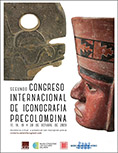Zea E-Books

Segundo congreso internacional de iconografía precolombina. Barcelona, 2023. Actas.
Date of this Version
2023
Document Type
Article
Citation
Publicado en Segundo congreso internacional de iconografía precolombina, 2023. Actas. Victòria Solanilla Demestre, editora. Lincoln, Nebraska: Zea Books, 2024. doi: 10.32873/unl.dc.zea.1722
Abstract
Este estudio iconográfico e iconológico se enfoca en el análisis de las imágenes de unos seres antropomorfos con rasgos naturalísticos, en el arte Tiwanaku. Los personajes estudiados se encuentran preferentemente pintados en objetos ceremoniales cerámicos y su presencia en la iconografía tiwanakota es bastante escasa. Las representaciones de estos seres mostrarían específicas características que indicarían estar cumpliendo unas acciones rituales. Las piezas estudiadas para esta investigación mostrarían una heterogeneidad de estilos tiwanakotas en los cuales se respetarían unas únicas y precisas normas de composición. Estos iconos representarían unas figuras humanas con rasgos naturalísticos participando en unas ceremonias rituales; mostrando la existencia de una tipología de personajes tiwanakotas libres de signos-emblemas de animales tutelares, y al mismo tiempo, caracterizados por tener una fuerte connotación espiritual. Se trataría de imágenes mágico-activas, que encerraban y difundían unos principios cósmicos-religiosos de la cultura Tiwanaku y revelarían unas particulares experiencias de lo sagrado propias de esta antigua civilización.
This iconographic and iconological study focuses on the analysis of the images of anthropomorphic beings with naturalist features, in Tiwanaku art. The characters studied are mainly painted in ceramic ceremonial objects and their presence in tiwanakota iconography is quite scarce. The representations of these beings show specific characteristics that would indicate that they were performing some ritual actions. The pieces studied for this research show a heterogeneity of tiwanakota styles in which unique and precise rules of composition were respected. These icons represent human figures with natural features participating in ritual ceremonies; showing the existence of a typology of tiwanakotas characters free of signs-emblems of tutelary animals, and at the same time, characterized by having a strong spiritual connotation. These were magical- active images, which contained and spread cosmic-religious principles of the Tiwanaku culture and revealed particular experiences of the sacred characteristic of this ancient civilization.


Comments
Copyright © 2023 Elisa Cont.